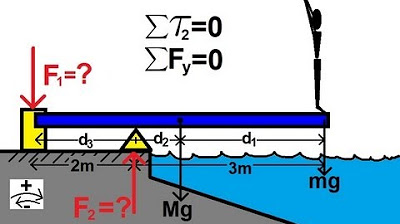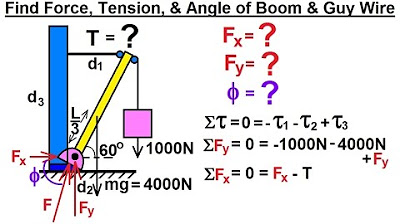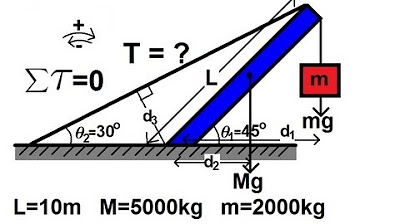Physics 15 Torque (20 of 25) More Examples: 2 F=? of Screw on Bracket
TLDRThe video script explores the practical application of torque in physics, specifically in the context of hanging a bracket on a wall to support a flowerpot weighing 200 Newtons. The discussion involves calculating the force exerted on a screw that secures the bracket, considering the pivot point and the distances involved. By applying the principle that the sum of torques around the pivot point must equal zero, the script guides through the process of calculating the force on the screw. It emphasizes the importance of a longer moment arm to increase torque and prevent shearing off due to excessive weight. The final calculation reveals that a force of approximately 71.4 Newtons is exerted on the screw, highlighting the need for a sufficiently large screw to handle the weight without failure.
Takeaways
- 🔩 The concept of torque is used to determine the force on a screw holding a bracket to a wall.
- 🌟 Torque is calculated by multiplying the force applied by the perpendicular distance from the pivot point.
- ⚖️ The sum of all torques about a pivot point must equal zero for equilibrium.
- 📐 The pivot point is crucial in calculating torque; it's the point around which the bracket would rotate.
- 🏗️ The force of the screw holding the bracket against the wall creates a clockwise torque, which is considered negative.
- 🔵 The weight at the end of the bracket creates a counterclockwise torque, which is considered positive.
- 📏 Distances are measured from the line of action of the force to the pivot point to calculate torque.
- 🔢 The force on the screw is determined by setting up an equation where the sum of torques equals zero and solving for the unknown force.
- 💡 A longer moment arm (distance from the force to the pivot point) results in a lower force needed to achieve the same torque, which is why brackets often have an extended end.
- 🔨 The size of the screw is important to prevent shearing off under the weight of the object placed on the bracket.
- ⚒️ Ensuring the screw is large enough is crucial to handle the shearing force and maintain the bracket's stability.
Q & A
What is the concept of torque in physics?
-Torque is a measure of the rotational force acting on an object. It is defined as the product of the force applied and the perpendicular distance from the pivot point (where the object rotates) to the line of action of the force.
Why is torque important when considering the strength of a screw holding a bracket to a wall?
-Torque is important because it determines the rotational force that the screw can withstand. A higher torque means the screw can hold more weight without rotating or coming loose.
What is the weight of the object placed on the bracket in the given scenario?
-The weight of the object placed on the bracket is 200 Newtons.
How is the pivot point determined in this scenario?
-The pivot point is determined by the point at which the bracket is attached to the wall. In this case, it is the point where the screw is inserted.
What is the distance from the pivot point to the point where the weight is applied?
-The distance from the pivot point to the point where the weight is applied is 4 meters.
What is the distance from the pivot point to the bottom of the bracket?
-The distance from the pivot point to the bottom of the bracket is 18 centimeters.
How do you calculate the force on the screw?
-The force on the screw is calculated by considering the torques acting on the bracket. The sum of the torques (one from the weight and one from the screw) must equal zero. By setting up an equation with the known values, you can solve for the unknown force on the screw.
What is the calculated force on the screw in Newtons?
-The calculated force on the screw is 71.4 Newtons.
Why is it important to have a longer end on the bracket?
-A longer end on the bracket increases the moment arm, which is the distance from the pivot point to the line of action of the force. A larger moment arm results in a greater torque, allowing the bracket to hold more weight.
What is the significance of the vertical forces in this scenario?
-The vertical forces translate to a shearing force on the screw. The screw must be strong enough to resist this shearing force to prevent it from being sheared off when weight is applied to the bracket.
Why is it necessary to have a screw that is large enough for the weight placed on the bracket?
-A larger screw provides a greater surface area to distribute the force, reducing the risk of the screw being sheared off. It ensures that the bracket can safely support the weight without coming loose or breaking.
What is the role of the drywall and wood in the stability of the bracket?
-The drywall provides a surface for the bracket to be attached to, while the wood (if present) provides a sturdy backing that allows the screw to be tightened securely. The combination of drywall and wood helps ensure that the bracket is stable and can support the applied weight.
Outlines
🔩 Understanding Torque in Bracket Installation
This paragraph discusses the application of torque in a practical scenario, specifically when installing a bracket on a wall to hold a flowerpot. The scenario involves calculating the force exerted by a screw on a bracket, given the weight of the flowerpot and the distances involved. The key points include identifying the pivot point, calculating torque due to the weight of the flowerpot and the force of the screw, and solving for the force on the screw. The calculation shows that a relatively small force (71.4 Newtons) is required to hold the bracket in place, highlighting the importance of the length of the bracket's end to increase the moment arm for better torque.
Mindmap
Keywords
💡Torque
💡Pivot Point
💡Bracket
💡Screw
💡Newton
💡Moment Arm
💡Shearing Force
💡Drywall
💡Centimeters
💡Force
💡Equilibrium
Highlights
The concept of torque is applied to a practical everyday scenario involving a bracket and a screw.
A flowerpot weighing 200 Newtons is placed on a bracket to test the screw's strength.
The screw is located 4 meters below the top of the bracket, creating a leverage effect.
The pivot point of the bracket is identified as the key to understanding the torque forces involved.
Two torques are considered: one from the weight at the end of the bracket and one from the screw.
The sum of all torques about the pivot point must equal zero, according to the principle of equilibrium.
Counterclockwise torque caused by the weight is considered positive, while the clockwise torque from the screw is negative.
The perpendicular distance from the line of action of the force to the pivot point is crucial for calculating torque.
The force of the screw is calculated by balancing the torques and using the given distances.
The calculated force on the screw is 71.4 Newtons, indicating a relatively low strain on the screw.
The length of the bracket's end is designed to increase the moment arm and improve torque efficiency.
Vertical forces from the weight are translated to a shearing force on the screw, which must be strong enough to prevent shearing.
The size of the screw is important to handle the weight without shearing off when too much weight is applied.
The practical application of torque is demonstrated through the example of a bracket and screw, showing its relevance in real-world scenarios.
The importance of considering both the force and the distance in torque calculations is emphasized.
Units of measurement (Newtons and centimeters) are used to calculate force, with the understanding that consistent units are essential.
The transcript provides a step-by-step explanation of how to apply the concept of torque to a practical problem.
Transcripts
Browse More Related Video

Torque Example #3: Leaning Ladder Problem

Physics 15 Torque Example 4 (4 of 7) The Diving Board

Physics 15 Torque Example 2 (2 of 7) Mass on Rod and Cable

Physics 15 Torque (1 of 27) Boom and Guy Wire

Physics 15 Torque (16 of 25) Body Mechanics: Ex. 4, F=? Jaw Muscle

Physics 15 Torque Example 3 (3 of 7) Mass on Rod and Cable
5.0 / 5 (0 votes)
Thanks for rating: